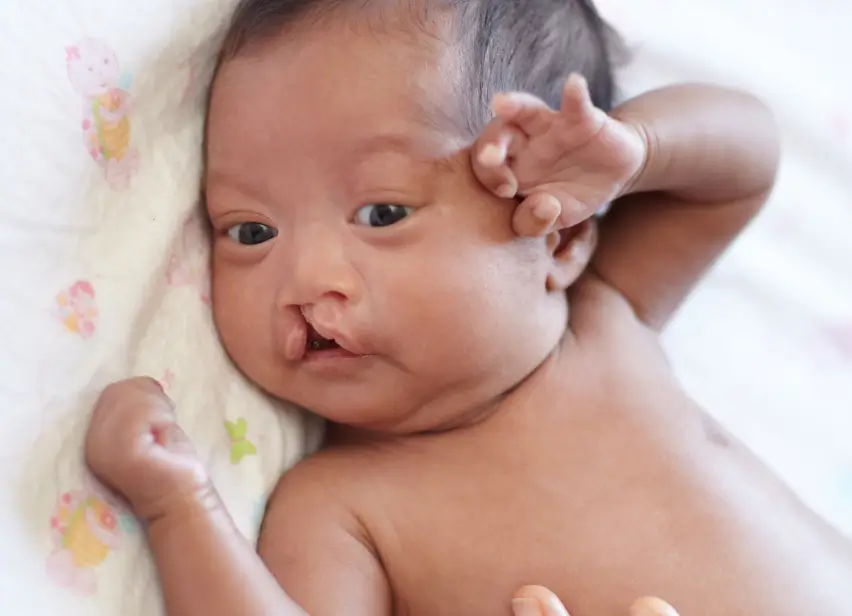At Prof Chrysis Sofianos Plastic Surgery Johannesburg, we specialise in the precise and compassionate repair of cleft lip and palate to restore function, appearance, and confidence for patients of all ages. With extensive experience in this complex surgery, Prof Sofianos brings world-class expertise to each case, transforming lives with advanced techniques and patient-centred care.
In addition to his private practice, Prof Sofianos regularly participates in humanitarian missions with the Smile Foundation and Operation Smile, extending his skills to those in need across the globe.

What are Cleft Lip and Palate?
Cleft lip and cleft palate are congenital conditions that occur when a baby’s lip or roof of the mouth (palate) doesn’t fully form during pregnancy.
- Cleft Lip: A gap in the upper lip that may range from a small notch to a large opening extending into the nose.
- Cleft Palate: A gap in the roof of the mouth that can involve the hard palate (front part), soft palate (back part), or both.
These conditions can impact:
- Appearance: Creating visible gaps in the lip or palate.
- Feeding: Difficulty sucking or swallowing.
- Speech: Impaired speech development due to the palate’s role in articulation.
- Hearing: Increased risk of ear infections and hearing loss.
- Dental Health: Issues with tooth alignment and gum development.
The Importance of Cleft Lip and Palate Repair
Timely cleft lip and palate repair is essential for improving a patient’s quality of life. Surgical repair addresses both functional and aesthetic concerns, allowing patients to:
- Eat and drink more effectively.
- Develop clear speech.
- Reduce the risk of ear infections and other complications.
- Achieve a more natural appearance, boosting confidence.
Cleft Lip and Palate Repair Techniques
Cleft Lip Repair
- Timing: Typically performed at 3–6 months of age.
- Procedure:
- Involves precise reconstruction of the lip muscles, skin, and underlying structures to create a natural appearance and restore function.
- Incisions are carefully placed to minimise visible scarring.
Cleft Palate Repair
- Timing: Performed at 9–12 months of age, depending on the patient’s health and development.
- Procedure:
- Reconstructs the palate to close the gap and restore the ability to eat and speak effectively.
- Techniques may include repositioning of the soft palate muscles to improve speech function.
Secondary Surgeries
- In some cases, additional surgeries may be required as the child grows to refine the appearance, improve speech, or address dental issues.

Prof Chrysis Sofianos: Transforming Lives with Humanitarian Missions
Prof Sofianos is deeply committed to giving back through his involvement with the Smile Foundation and Operation Smile.
- Smile Foundation: A leading South African organisation providing life-changing surgery for children with cleft conditions.
- Operation Smile: An international charity that provides free cleft surgery to underserved communities worldwide.
Through these missions, Prof Sofianos has honed his expertise in cleft repair while providing hope and transformation to hundreds of children and families.
Your Cleft Repair Journey
Personalised Consultation
- Evaluate the cleft condition in detail.
- Discuss the surgical plan, timeline, and expected outcomes.
- Address any concerns and provide guidance for pre- and post-operative care.
Surgical Procedure
Recovery and Follow-Up
- Recovery: Initial healing occurs within 1–2 weeks, with full recovery over several months.
- Follow-Up: Regular check-ups monitor healing, speech development, and overall progress.

FAQs About Cleft Lip and Palate Repair
1. How successful is cleft repair surgery?
Cleft repair surgery is highly successful in restoring function and improving appearance, with most patients achieving excellent long-term results.
2. Will my child need additional surgeries?
Some patients may require secondary procedures for speech improvement, dental issues, or aesthetic refinement as they grow.
3. Can adults have cleft repair surgery?
Yes, adults with untreated cleft conditions can benefit from surgical repair and aesthetic improvement.
4. How does cleft repair impact speech?
Surgical repair of the palate significantly improves speech clarity by addressing the structural issues affecting sound production.
Table of Contents
Transform your or your child’s life with expert cleft lip and palate repair at Prof Chrysis Sofianos Plastic Surgery Johannesburg. Contact us today to schedule your consultation and learn more about how our compassionate care and advanced techniques can restore function and confidence.
